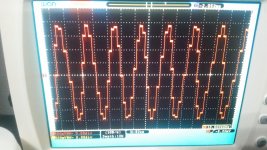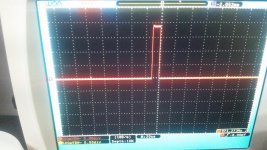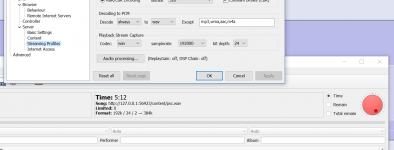Audirvana + iZotope 64bit SR ?
Hi Michael,
Nice findings that you did.
So better upsampling (8x 44.1/48) with more taps gives more natural sound.
I searched for other upsampling plugins for foobar, but I only found a VST adapter for foobar.
I have no idea if there are any VST upsampling plugins.
Something better seems to be Audirvana.
It already existed for Mac but now there's also a windows version, here's the trial download.
It uses SoX or iZotope 64bit SR.
I haven't tested it yet, I'm still in the Austrian alps 🙂
Compared to fb2k SoX, the poly-sinc-xtr is clearly softer and more natural, in the exact same direction of change from the FPGA filters to the SoX filters, as far as I can tell.
Hi Michael,
Nice findings that you did.
So better upsampling (8x 44.1/48) with more taps gives more natural sound.
I searched for other upsampling plugins for foobar, but I only found a VST adapter for foobar.
I have no idea if there are any VST upsampling plugins.
Something better seems to be Audirvana.
It already existed for Mac but now there's also a windows version, here's the trial download.
It uses SoX or iZotope 64bit SR.
I haven't tested it yet, I'm still in the Austrian alps 🙂
Last edited:
Different sampling rates. A real square wave consists of very high frequencies. What you see on the oscilloscope would not contain those frequencies if the signal is actually say 96Khz. Sampling theorem says 96Khz reproduces signals up to 48Khz no?...
The statements are separately true, the buzz words are all in place, but sense they make not.
Again, this is the output of Newnos from a 10kHz signal, sampled @96kHz. How is it not NOS? And the single pulse response again @96kHz.
Attachments
...had weaker bass than poly-sinc-xtr, and probably less natural too.... [/url]
... in your system.
Maybe you would like to fire less bold swift statements about these products. Especially after what seem to be 7 minutes evaluation. You stated previously that your are unsure of your own listening ability and rather trust your first best stranger on the www. I really cant take your forced super speed, techno-babble ridden evaluation foray serious, and if I where you, I'd watch for potential "trade mark" dilution.
I also find the performance magnitude figure driven gold-digging approach troublesome to say the least.
Observation from the rink-side. Points for enthusiasm and entertainment value though! :-D
//
Last edited:
Hi Michael,
Nice findings that you did.
So better upsampling (8x 44.1/48) with more taps gives more natural sound.
I searched for other upsampling plugins for foobar, but I only found a VST adapter for foobar.
I have no idea if there are any VST upsampling plugins.
Something better seems to be Audirvana.
It already existed for Mac but now there's also a windows version, here's the trial download.
It uses SoX or iZotope 64bit SR.
I haven't tested it yet, I'm still in the Austrian alps 🙂
Enjoy the trip! 🙂 I tried VST but it didn’t work out. I think there’s something limiting about what a VST can do (change output sample rate?), and that there’s no one writing resamplers for foobar... the best case would be an Izotope Src resampler plugin but given that foobar is 32bits there isn’t much hope..
Try the HQPlayer, it’s better than resampler-V by quite a bit!
The statements are separately true, the buzz words are all in place, but sense they make not.
Again, this is the output of Newnos from a 10kHz signal, sampled @96kHz. How is it not NOS? And the single pulse response again @96kHz.
It is. But the DAC could well be operating at 3Mhz to produce it. In any case it sounded harsher than OS and nothing like a TotalDAC contrary to what people hoped.
... in your system.
Maybe you would like to fire less bold swift statements about these products. Especially after what seem to be 7 minutes evaluation. You stated previously that your are unsure of your own listening ability and rather trust your first best stranger on the www. I really cant take your forced super speed, techno-babble ridden evaluation foray serious, and if I where you, I'd watch for potential "trade mark" dilution.
I also find the performance magnitude figure driven gold-digging approach troublesome to say the least.
Observation from the rink-side. Points for enthusiasm and entertainment value though! :-D
//
You should believe me. Test it on your own system and you’ll see how pointless the doubts are... I use HD650 on the buffered out, probably not the most transparent but not that much coloration in the chain either. What do you mean by dilutions?.... the reduction in harshness is 100% real, and probably measurable. Worth questioning whether it’s an improvement, but I cant see anything wrong with a more perfectly upsampled signal.
They’re not bit perfect at all. Upsampling create artifacts. Just look at the THD plot I posted...
Would you like to read what i've written again? Obviously a bit perfect output demands than no upsampling algos are employed.
Would you like to read what i've written again? Obviously a bit perfect output demands than no upsampling algos are employed.
I see. Then I don’t expect differences between players of course, and wouldn’t believe it if anyone reported such. However, it is a sad fact that Soekris sounds harsh in NOS and we can’t change it, whatever the underlying hardware causes are. I’m very happy with the results I’m getting, and it’s good to know we might be getting some sort of theoretical guarantee with oversampling (given powerful filters!). I definitely don’t mind getting real sine waves rather than what you see in NOS. Can we hear the difference if both are perfect? Theory tells us no. Do I intend on buying a totaldac to compare? Well...
Hi Michael, Yogi,
Nice you get good results with upsampling that resilts in long listening sessions 🙂
Now let's try iZotope.
Besides HQplayer and Jriver, there's also a new mediaplayer for windows: Audirvana.
It uses the iZotope 64bit SR
There's a trial download.
Doesn’t work I tried it! Version 3 with izotope only available on Mac! The main advantage of isotope I believe comes from the length of the filter, which is also utilized in HQP. It seems Izotope gets marginally better measurement, but maybe the latest HQP is even better than what we see in the comparator, equaling Izotope. Someone with a Mac can try it out though...
Last edited:
Captured? They’re just upsampled using nearly perfect super long filters. Theoretically, if you can have arbitrary long filters the upsampling should be perfect. I read somewhere that 1M taps is considered perfect enough, not sure how they justified it but I believe them. It’s hard to do without a computer because we have LX15 Spartan 6 onboard which limits the computation abilities. In comparison Chord Dave uses LX75 which as its name suggests is 5x more powerful. The top of the line is LX150 which costs more than $200 a piece. Again it would be nice if everything can be handled onboard, but there’s added cost and using too much power onboard (assuming the FPGAs won’t be that much more efficient) may not be worth it. You just need to find good software resamplers...
What I meant was that on the recording side of things the "pefect" signal you are listening to now went through an oversampling ADC (almost all of them sigma delta since the late 80s) utilizing comparably crude filter algorithms. Also, during mixing and mastering the music probably went through several AD - DA stages again.
So it should be possible to get good quality, non-harsh-sounding audio with relatively simple filters. BTW, the insides of the most revered studio AD and DA converters today are basically all from the 90s (Pacific Microsonics, Lavy Gold, Prism Dream).
What I meant was that on the recording side of things the "pefect" signal you are listening to now went through an oversampling ADC (almost all of them sigma delta since the late 80s) utilizing comparably crude filter algorithms. Also, during mixing and mastering the music probably went through several AD - DA stages again.
So it should be possible to get good quality, non-harsh-sounding audio with relatively simple filters. BTW, the insides of the most revered studio AD and DA converters today are basically all from the 90s (Pacific Microsonics, Lavy Gold, Prism Dream).
Good points. Not sure if it matters how imperfect the mastering are... we don’t want to add more distortion through suboptimal filters onboard in DA process. I read on stackexchange that the Lake DSP which is before the 90s have 200k+ taps. There’s a good reason for that.
This might be a motivation for Soren to release his ADC design as a product...something that doesn’t require the far from perfect SD processing
Edit: can you try HQPlayer in 192k/96k with 48khz files? I think it would make a very audible difference... the improvement is what justifies the investment in a more complex implementation, right
Edit2: not sure if you meant I’m doing extra ADC, it’s more DDC and I believe with a large enough filter, such as Izotope or HQPlayer poly-sinc-xtr, there are theoretical guarantees on the perfection of the conversion process - something you cannot achieve with a 2k or 4K tap filter onboard
Last edited:
Thanks for trying.Doesn’t work I tried it! Version 3 with izotope only available on Mac!
Maybe this will be available in a future release, Audirvana is completely new for windows.
Thanks for trying.
Maybe this will be available in a future release, Audirvana is completely new for windows.
Yep. But I also hate the audirvana interface. It's almost unbearable imo 🙂
Found this and investigating: Stream to HQPlayer Desktop from foobar2000 - Software - Audiophile Style
Found this and investigating: Stream to HQPlayer Desktop from foobar2000 - Software - Audiophile Style
That's very interesting, I like the foobar interface but dislike the HQplayer interface (too basic).
So both working together would be great.
Got it to work. Quite a clever solution, only problem is that you have to manually toggle the sample rate in upnp server setting when it changes in the tracks. Note that if you're using one computer, type 127.0.0.1 as the ip address followed by port. It doesn't recognize 'localhost'.
Doubles the CPU usage to 6% due to Fb2k, but quite worth it in my opinion. Keeping two apps open isn't too much hassle. Fb2k conversion to wav should be flawless and it enables you to listen to many more file formats than HQPlayer supports. Very satisfying for someone not into DSD like myself...
Doubles the CPU usage to 6% due to Fb2k, but quite worth it in my opinion. Keeping two apps open isn't too much hassle. Fb2k conversion to wav should be flawless and it enables you to listen to many more file formats than HQPlayer supports. Very satisfying for someone not into DSD like myself...
Attachments
Last edited:
Then I don’t expect differences between players of course, and wouldn’t believe it if anyone reported such.
Expect vs Reported vs I tried
How long does a test like this take? For you, less than a 100mS 🙂
Expect vs Reported vs I tried
How long does a test like this take? For you, less than a 100mS 🙂
That's great right? Otherwise you have to test everything in the world and that'd be quite ineffective. I'm not a pragmatist but there is certainly something in it
You are right. Things like this, once heard cannot be unheard. Dangerous grounds.
Please don't argue that two bit-perfect software will have different sounds, everything else equal... It's okay I guess if you believe it, but I find difficulties in doing so.
Edit: I now realize that maybe there could be differences in jitter performance, or the frequency of buffer overflows? That aside, my point stands... I'm not rejecting the possibility that Amanero could sound worse than XMOS on dam1021 either, but as it is I don't see why I would do anything about it... I would be way more worried about the "botched" FPGA reclocking on dam1021 compared to dam1121, and even that comes after worries about the distortions of onboard buffers compared to a full-fledged head amp...
Last edited:
I seriously doubt if the MSB Femto 33 with $19,900 MSRP is more effective than the SoX to HQPlayer upgrade. Soren, you might want to investigate... They have 768kHz proprietary USB inputs though so we can't beat them there... Is there a chance that FIR2 can still be improved if more (or all) resources from FIR1 are reallocated to it?
I can't really tell if the sound of flute should be smoother or if that's just how it is. Someone who clocked more hours in concert halls recently need to share their experience... I guess I wouldn't be surprised if there's still some traces of digital harshness given the clocking setup in dam1021...
I don't think I'm being overdramatic at all. With this software tweak I would have no problem with the initial marketing terms that Soren used. Just based on my intuitions, haven't heard a totaldac or msb dac.
I can't really tell if the sound of flute should be smoother or if that's just how it is. Someone who clocked more hours in concert halls recently need to share their experience... I guess I wouldn't be surprised if there's still some traces of digital harshness given the clocking setup in dam1021...
I don't think I'm being overdramatic at all. With this software tweak I would have no problem with the initial marketing terms that Soren used. Just based on my intuitions, haven't heard a totaldac or msb dac.
Attachments
Last edited:
- Status
- Not open for further replies.
- Home
- Source & Line
- Digital Line Level
- Musings on soekris Reference Dac Module



